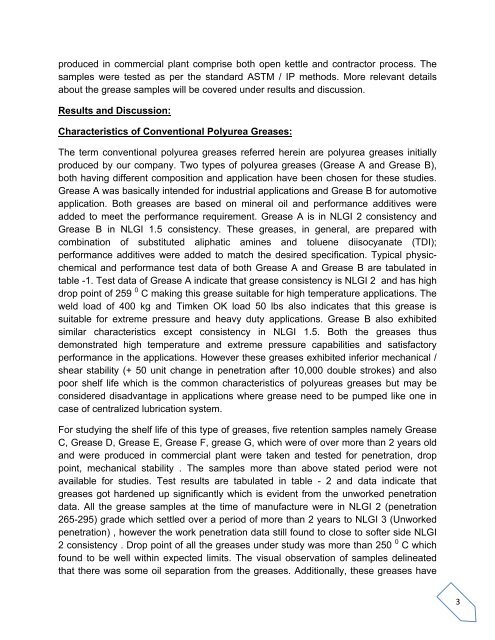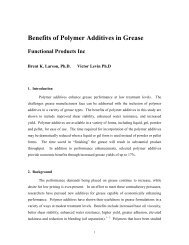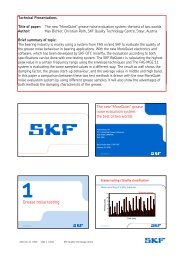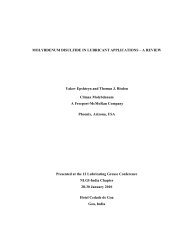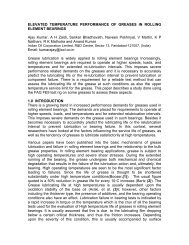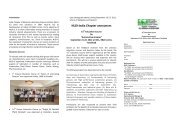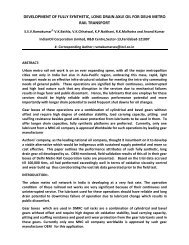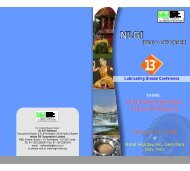âRobust Polyurea Grease for Wide Range of Industrial Applications ...
âRobust Polyurea Grease for Wide Range of Industrial Applications ...
âRobust Polyurea Grease for Wide Range of Industrial Applications ...
You also want an ePaper? Increase the reach of your titles
YUMPU automatically turns print PDFs into web optimized ePapers that Google loves.
produced in commercial plant comprise both open kettle and contractor process. Thesamples were tested as per the standard ASTM / IP methods. More relevant detailsabout the grease samples will be covered under results and discussion.Results and Discussion:Characteristics <strong>of</strong> Conventional <strong>Polyurea</strong> <strong>Grease</strong>s:The term conventional polyurea greases referred herein are polyurea greases initiallyproduced by our company. Two types <strong>of</strong> polyurea greases (<strong>Grease</strong> A and <strong>Grease</strong> B),both having different composition and application have been chosen <strong>for</strong> these studies.<strong>Grease</strong> A was basically intended <strong>for</strong> industrial applications and <strong>Grease</strong> B <strong>for</strong> automotiveapplication. Both greases are based on mineral oil and per<strong>for</strong>mance additives wereadded to meet the per<strong>for</strong>mance requirement. <strong>Grease</strong> A is in NLGI 2 consistency and<strong>Grease</strong> B in NLGI 1.5 consistency. These greases, in general, are prepared withcombination <strong>of</strong> substituted aliphatic amines and toluene diisocyanate (TDI);per<strong>for</strong>mance additives were added to match the desired specification. Typical physicchemicaland per<strong>for</strong>mance test data <strong>of</strong> both <strong>Grease</strong> A and <strong>Grease</strong> B are tabulated intable -1. Test data <strong>of</strong> <strong>Grease</strong> A indicate that grease consistency is NLGI 2 and has highdrop point <strong>of</strong> 259 0 C making this grease suitable <strong>for</strong> high temperature applications. Theweld load <strong>of</strong> 400 kg and Timken OK load 50 lbs also indicates that this grease issuitable <strong>for</strong> extreme pressure and heavy duty applications. <strong>Grease</strong> B also exhibitedsimilar characteristics except consistency in NLGI 1.5. Both the greases thusdemonstrated high temperature and extreme pressure capabilities and satisfactoryper<strong>for</strong>mance in the applications. However these greases exhibited inferior mechanical /shear stability (+ 50 unit change in penetration after 10,000 double strokes) and alsopoor shelf life which is the common characteristics <strong>of</strong> polyureas greases but may beconsidered disadvantage in applications where grease need to be pumped like one incase <strong>of</strong> centralized lubrication system.For studying the shelf life <strong>of</strong> this type <strong>of</strong> greases, five retention samples namely <strong>Grease</strong>C, <strong>Grease</strong> D, <strong>Grease</strong> E, <strong>Grease</strong> F, grease G, which were <strong>of</strong> over more than 2 years oldand were produced in commercial plant were taken and tested <strong>for</strong> penetration, droppoint, mechanical stability . The samples more than above stated period were notavailable <strong>for</strong> studies. Test results are tabulated in table - 2 and data indicate thatgreases got hardened up significantly which is evident from the unworked penetrationdata. All the grease samples at the time <strong>of</strong> manufacture were in NLGI 2 (penetration265-295) grade which settled over a period <strong>of</strong> more than 2 years to NLGI 3 (Unworkedpenetration) , however the work penetration data still found to close to s<strong>of</strong>ter side NLGI2 consistency . Drop point <strong>of</strong> all the greases under study was more than 250 0 C whichfound to be well within expected limits. The visual observation <strong>of</strong> samples delineatedthat there was some oil separation from the greases. Additionally, these greases have3


